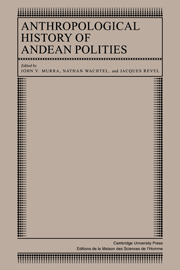Book contents
- Frontmatter
- Contents
- List of contributors
- Preface
- Introduction
- Part I Ecology and society
- Part II The ethnic group and the state
- 4 The expansion of the Inka state: armies, war, and rebellions
- 5 Storage, supply, and redistribution in the economy of the Inka state
- 6 The extraction of precious metals at the time of the Inka
- 7 Vertical politics on the Inka frontier
- Part III Systems of classification
- Part IV Symbolic representations and practices
- Part V From ethnic polities to communities
- Bibliography of published source
- Index
6 - The extraction of precious metals at the time of the Inka
Published online by Cambridge University Press: 05 October 2010
- Frontmatter
- Contents
- List of contributors
- Preface
- Introduction
- Part I Ecology and society
- Part II The ethnic group and the state
- 4 The expansion of the Inka state: armies, war, and rebellions
- 5 Storage, supply, and redistribution in the economy of the Inka state
- 6 The extraction of precious metals at the time of the Inka
- 7 Vertical politics on the Inka frontier
- Part III Systems of classification
- Part IV Symbolic representations and practices
- Part V From ethnic polities to communities
- Bibliography of published source
- Index
Summary
Although the “advanced civilizations” of Peru had used gold and silver long before the emergence of the Inka empire, it was only from the second half of the fifteenth century onward, with the extension of that empire, that the Andean mines were intensively exploited. The fabulous plunder taken by the conquistadores at Cajamarca and Cusco in 1533 and 1534 (10 tons of 22 ½ carat gold, 70 tons of fine silver) testifies to the fact that the last sovereigns of Tawantinsuyu had, in the space of a few decades, amassed considerable quantities of precious metals. This would presuppose the existence of intensive mining, the mobilization of many workers, and an organization of the mines at the state level. Who worked these mines, for whom, and how?
I shall concentrate upon two mining regions in Collasuyu, namely Carabaya and Chuquiabo. The first lies northeast of Lake Titicaca, on the eastern slope of the cordillera, in the montaña, the wooded slopes of the Amazonian piedmont of the Andes, 1,500 to 2,500 meters above sea level. The second lies southeast of the lake, near La Paz, in a heavily eroded basin of the upper Andean plateau, at an average elevation of 3,600 meters. These were the two most important centers for the production of gold in the southern part of Tawantinsuyu, and the only two, to my knowledge, on which we have information that is in any sense detailed (see the map, Fig. 6.1).
- Type
- Chapter
- Information
- Anthropological History of Andean Polities , pp. 69 - 88Publisher: Cambridge University PressPrint publication year: 1986
- 31
- Cited by



